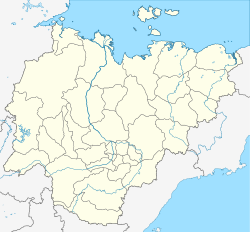
The Spafaryev Islands, or Spafaryev Island, a relatively large double island, are located in the Sea of Okhotsk. It was formerly known as Korovi Island. It lies 7 km east of the Antamlan Peninsula, the southernmost peninsula enclosing the Taui Bay from its western side.

Boatin Island is the rocky island off the northwest coast of Robert Island in the South Shetland Islands extending 740 m in north–south direction and 150 m wide. It ends in the T-shaped 250 m wide Hammer Point to the north, and connected to Robert Island to the south by a 250 m long moraine tombolo. The feature was formed as a result of the retreat of Robert Island's ice cap during the first decade of 21st century. The area was visited by early 19th century sealers.

Grod Island is the southernmost island in the Onogur group off the northwest coast of Robert Island in the South Shetland Islands, Antarctica. The feature is low and ice-free, extending 610 m in east-west direction and 200 m wide. It is separated from Robert Island by a 130 m wide passage.

Kovach Island is the westernmost island in the Onogur group off the northwest coast of Robert Island in the South Shetland Islands, Antarctica. The feature is rocky, extending 630 m in southwest-northeast direction and 240 m wide. It is separated from Grod Island by a 100 m wide passage. The area was visited by early 19th century sealers.

Oescus Island is the low ice-free island in the Onogur group off the northwest coast of Robert Island in the South Shetland Islands, Antarctica extending 380 m in southeast–northwest direction and 40 m wide. The feature comprises two parts connected by a spit, and is separated from Redina Island, Kovach Island and Leeve Island by passages 120 m, 160 m and 130 m wide respectively.

Leeve Island is the low ice-free island in the Onogur group off the northwest coast of Robert Island in the South Shetland Islands, Antarctica extending 200 m in southeast-northwest direction and 80 m wide. It is separated from Redina Island by a 100 m wide passage.

Vilare Island is the low ice-free island in the Onogur group off the northwest coast of Robert Island in the South Shetland Islands, Antarctica extending 130 m in east-west direction and 60 m wide. It is separated from Churicheni Island by a 20 m wide passage.

Churicheni Island is the ice-free island in the Onogur group off the northwest coast of Robert Island in the South Shetland Islands, Antarctica extending 230 m by 140 m. It is separated from Robert Island by a 100 m wide passage.

Osenovlag Island is the easternmost island in the Onogur group off the northwest coast of Robert Island in the South Shetland Islands, Antarctica. It is named after the settlement of Osenovlag in Western Bulgaria.

Svetulka Island is the northernmost island in the Onogur group off the northwest coast of Robert Island in the South Shetland Islands, Antarctica. The feature is rocky, extending 150 by 90 metres, and separated from Osenovlag Island by a 20-metre (66 ft) wide passage. The area was visited by early 19th century sealers.

Pisanitsa Island is the rocky island in the Meade group off Archar Peninsula, the northwest extremity of Greenwich Island in the South Shetland Islands extending 270 m in southwest-northeast direction and 60 m wide. The area was visited by early 19th century sealers.

Melyane Island is the southernmost of Dunbar Islands off Varna Peninsula, Livingston Island in the South Shetland Islands. The feature is ice-free, extending 280 m in southeast-northwest direction and 90 m wide. The area was visited by early 19th century sealers.

Pogledets Island is the northernmost of Dunbar Islands off Varna Peninsula, Livingston Island in the South Shetland Islands. The feature is ice-free, crescent shaped facing southwest, and extending 200 m in north-south direction and 170 m in east-west direction. The area was visited by early 19th century sealers.
Kormoran Island is the mostly ice-free rocky island extending 848 m in south–north direction and 705 m in west–east direction in the Vedel Islands group of Wilhelm Archipelago in the Antarctic Peninsula region. Its surface area is 36.7 ha.
Bodloperka Island is the partly ice-free island 688 m long in south-southwest to north-northeast direction and 473 m wide in the Dannebrog Islands group of Wilhelm Archipelago in the Antarctic Peninsula region. Its surface area is 22.43 ha.
Meduza Island is the partly ice-covered island extending 670 m in southwest–northeast direction and 434 m in north–south direction in the Dannebrog Islands group of Wilhelm Archipelago in the Antarctic Peninsula region. Its surface area is 11.9 ha.
Kalmar Island is the mostly ice-covered island 1.12 km long in west-southwest to east-northeast direction and 245 m wide in the Dannebrog Islands group of Wilhelm Archipelago in the Antarctic Peninsula region. Its surface area is 16.15 ha.
Kril Island is the mostly ice-covered island 1.2 km long in southwest–northeast direction and 310 m wide in the Wauwermans Islands group of Wilhelm Archipelago in the Antarctic Peninsula region. Its surface area is 24.92 ha.
Mida Island is the rocky island 204 m long in west–east direction and 93 m wide, part of Vetrilo Rocks in the Wauwermans Islands group of Wilhelm Archipelago in the Antarctic Peninsula region. Their surface area is 1.15 ha.
Yrvind Island is the rocky island off the northwest coast of Nelson Island in the South Shetland Islands, Antarctica 165 m long in south–north direction and 70 m wide. Its surface area is 0.8 ha. The vicinity was visited by early 19th century sealers.





